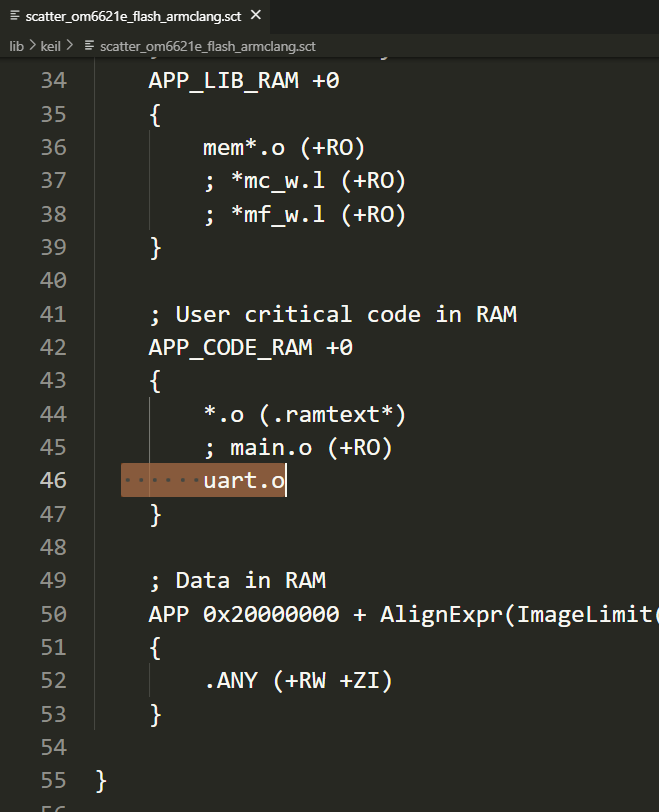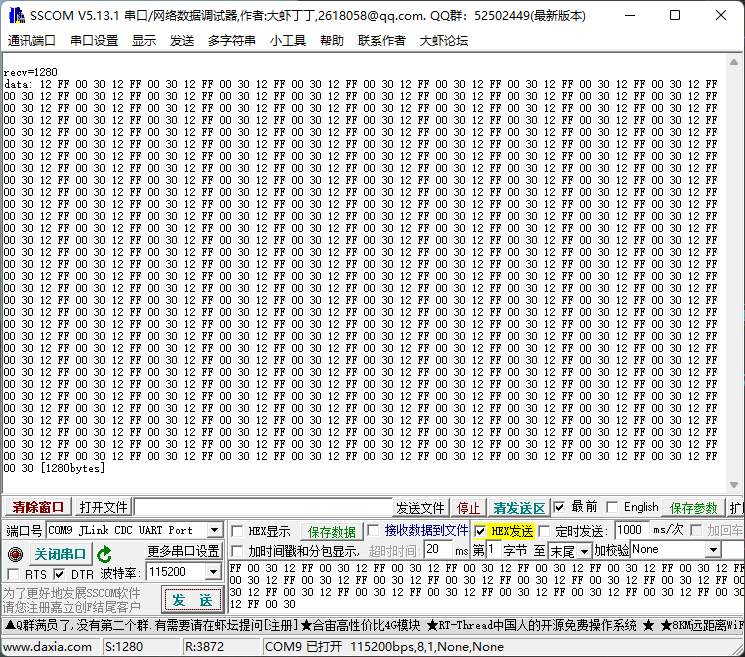|
通过使能UART1 FIFO模式,并结合CTI中断,实现从1~1500字节 连连续不丢码接收 主要按以下三步骤来进行 (1) 首先,参考下文,加入uart.c 为源文件编译模式 6621E 外设源文件编译修改例程(uart)-昂瑞微论坛BBS (onmicro.com.cn) (2) 配置FIFO模式,8字节FIFO接收中断加超时5ms读取数据。 (3)为了进一步提高处理速度,可以把uart.c 加入到 sram 中执行。 ..\..\..\..\lib\keil\scatter_om6621e_flash_armclang.sct
uart.c 代码示例 /********************************************************************* * @file uart.c * @brief * @version 1.0 * @date Wed 19 Nov 2014 04:11:47 PM CST * @author Onmicro * * @note */ /********************************************************************* * INCLUDES */ #include "features.h" #include "hs66xx.h" #include "uart.h" #include "cpm.h" #include "co_evt.h" /********************************************************************* * MACROS */ #define MODE_X_DIV 16 #define ISO7816_RX_MODE 1 #define ISO7816_TX_MODE 0 #define UART_TIMEOUT (1024 * 1024 * 2) /********************************************************************* * TYPEDEFS */ typedef struct { uart_rx_callback_t rx_cb; uart_tx_cmp_callback_t tx_cmp_cb; } uart_callback_t; typedef struct { uart_callback_t uart[1]; } uart_env_t; /********************************************************************* * CONSTANTS */ volatile char uart1_dma_recv_flag = false; /********************************************************************* * LOCAL VARIABLES */ static uart_env_t uart_env; /********************************************************************* * GLOBAL VARIABLES */ /********************************************************************* * LOCAL FUNCTIONS */ /** * @brief uart_check_irq() * * @param[in] uart * * @return **/ #define CNT_MAX (1500) //最多连接接收字符数 #define TIMEOUT_MS (5) //暂停超时 uint16_t recv_byte_cnt = 0;/*每帧接收计数*/ char recv_buffer[CNT_MAX];/*接收缓冲,可以不必须清空*/ void uart1_reset_recv_timeout(void); static co_timer_t uart_recv_break_timer; static void uart_recv_break_timer_handler(co_timer_t *timer, void *param) { //1-打印接收字节数 log_debug("\nrecv=%d", recv_byte_cnt); //2-接收数据处理,需要读取到其它地方,进行处理 log_debug_array_ex("\ndata", recv_buffer, recv_byte_cnt); //3-清0计数器,重新接收 recv_byte_cnt = 0; } /** * @brief 如果(TIMEOUT_MS)ms内没有新的数据,表示此次接收完毕,连续接收数不超过 CNT_MAX */ void uart1_reset_recv_timeout(void) { co_timer_set(&uart_recv_break_timer, TIMEOUT_MS, TIMER_ONE_SHOT, uart_recv_break_timer_handler, NULL); } static void uart_check_irq(HS_UART_Type *uart, uart_callback_t *uart_cb) { uint8_t status; volatile uint8_t ch; while (1) { status = uart->IIR & UART_IIR_ID; switch (status) { case UART_IIR_RDI: /* Receiver data interrupt */ { while (uart->LSR & UART_LSR_DR) { recv_buffer[recv_byte_cnt] = uart->RBR; if (recv_byte_cnt < CNT_MAX) recv_byte_cnt++; } uart1_reset_recv_timeout(); } break; case UART_IIR_THRI: uart->IER &= ~UART_IER_THRI; if (uart_cb->tx_cmp_cb) uart_cb->tx_cmp_cb(); break; case UART_IIR_NO_INT: return; case UART_IIR_BDI: status = uart->USR; break; case UART_IIR_RLSI: ch = uart->LSR; break; case UART_IIR_CTI:/* character timeout */ { while (uart->LSR & UART_LSR_DR) { recv_buffer[recv_byte_cnt] = uart->RBR; if (recv_byte_cnt < CNT_MAX) recv_byte_cnt++; } uart1_reset_recv_timeout(); } break; default: break; } } } /********************************************************************* * PUBLIC FUNCTIONS */ /** * @brief uart initialize * * @param[in] uart uart object * @param[in] baud_rate baud rate * @param[in] flow_ctrl flow control (Only UART1 support) * @param[in] uart_rx_cb receive callback * * @return None **/ void uart_open(HS_UART_Type *uart, uint32_t baud_rate, uart_flow_ctrl_t flow_ctrl, uart_rx_callback_t uart_rx_cb) { uint16_t baud_divisor; // Reset and Bypass UART1 register_set1(&HS_PSO->UART1_CFG, CPM_UART_SOFT_RESET_MASK); register_set0(&HS_PSO->UART1_CFG, CPM_UART_DIV_SEL_MASK | CPM_UART_GATE_EN_MASK); HS_PSO_UPD_RDY(); uart_env.uart[0].tx_cmp_cb = NULL; uart_env.uart[0].rx_cb = NULL; /* Compute divisor value. Normally, we should simply return: * NS16550_CLK / MODE_X_DIV / baudrate * but we need to round that value by adding 0.5. * Rounding is especially important at high baud rates. */ if (cpm_get_clock(CPM_TOP_CLK) >= 32000000 && baud_rate < 19200) baud_divisor = 4; // make sure 9600bps is supported else baud_divisor = 1; cpm_set_clock(CPM_UART1_CLK, baud_divisor * baud_rate * MODE_X_DIV); // Disable LCR and irq uart->LCR = 0x00; uart->IER = 0; // Auto RTS – Becomes active when the following occurs: // - Auto Flow Control is selected during configuration // - FIFOs are implemented // - RTS (MCR[1] bit and MCR[5]bit are both set) // - FIFOs are enabled (FCR[0]) bit is set) // - SIR mode is disabled (MCR[6] bit is not set) if (flow_ctrl == UART_FLOW_CTRL_ENABLED) uart->MCR = UART_MCR_RTS | UART_MCR_AFCE; else uart->MCR = 0x00; /*FCR: FIFO Control Register*/ uart->FCR = UART_FCR_CLEAR_RCVR | UART_FCR_CLEAR_XMIT | UART_FCR_FIFO_EN | UART_FCR_TRIGGER_8; /* Baud rate setting.*/ uart->LCR = UART_LCR_DLAB; uart->DLL = baud_divisor & 0xff; uart->DLH = (baud_divisor >> 8) & 0xff; /* 8 data, 1 stop, no parity */ uart->LCR = UART_LCR_8N1; /* Set UARTs int mask */ if (uart_rx_cb) { uart->IER = UART_IER_RLSI | UART_IER_RDI; NVIC_ClearPendingIRQ(UART1_IRQn); NVIC_SetPriority(UART1_IRQn, IRQ_PRIORITY_HIGH); NVIC_EnableIRQ(UART1_IRQn); } else { uart->IER = 0; NVIC_DisableIRQ(UART1_IRQn); } uart_env.uart[0].tx_cmp_cb = NULL; uart_env.uart[0].rx_cb = uart_rx_cb; } /** * @brief uart send with noblock * * @param[in] uart uart object * @param[in] buf transmit data buffer * @param[in] length transmit data length * @param[in] txcb transmit complete callback * * @return None **/ void uart_send_noblock(HS_UART_Type *uart, uint8_t **buf, unsigned *length, uart_tx_cmp_callback_t txcb) { uint32_t count = *length; uint32_t fifo_len = 0; uart_env.uart[0].tx_cmp_cb = txcb; fifo_len = 16; if (count >= fifo_len) count = fifo_len; (*length) -= count; do { uart->THR = *((*buf)++); count--; } while (count); uart->IER |= UART_IER_THRI; } /** * @brief uart wait send finish @ref uart_send_noblock * * @param[in] uart uart object * * @return None **/ void uart_wait_send_finish(HS_UART_Type *uart) { while (!(uart->LSR & UART_LSR_TEMT)); } /** * @brief uart send with block * * @param[in] uart uart object * @param[in] buf transmit data buffer * @param[in] length transmit data length * * @return None **/ void uart_send_block(HS_UART_Type *uart, const uint8_t *buf, unsigned length) { unsigned i; for (i = 0; i < length; ++i) { while (!(uart->LSR & UART_LSR_THRE)); uart->THR = buf[i]; } while (!(uart->LSR & UART_LSR_TEMT)); } /** * @brief uart empty fifo * * @param[in] uart uart object * * @return None **/ void uart_empty_fifo(HS_UART_Type *uart) { volatile uint32_t data; while (uart->LSR & UART_LSR_DR) /* Read all characters out of the fifo */ data = uart->RBR; (void) data; } void UART1_IRQHandler(void) { uart_check_irq(HS_UART1, &uart_env.uart[0]); } 4 测试结果,发1280,收1280。 // Init UART uart_open(DEBUG_UART, DEBUG_UART_BAUDRATE, UART_FLOW_CTRL_DISABLED, uart_recv_cb); //callback 实际未使用,可以根据需要去使用
|
 uart-202311307524.c
uart-202311307524.c



